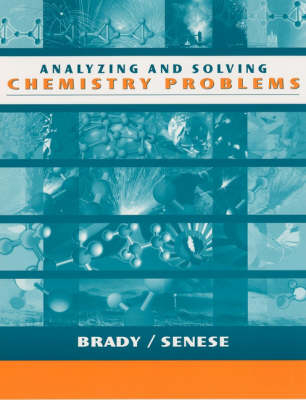
Analyzing and Solving Chemistry Problems
The Study of Matter and Its Changes
Seiten
2002
|
3rd Revised edition
John Wiley and Sons (WIE) (Verlag)
978-0-471-25496-6 (ISBN)
John Wiley and Sons (WIE) (Verlag)
978-0-471-25496-6 (ISBN)
- Titel ist leider vergriffen;
keine Neuauflage - Artikel merken
Intended for mainstream general chemistry courses for science and engineering students, this text is comprehensive in coverage and employs devices designed to enhance the reader's critical thinking and problem solving.
The images on the cover call attention to the relationship between macro observations and the intimate structure of chemical substances and the changes, both chemical and physical, that they undergo. Fireworks: One of the ingredients is phosphorus, a molecular form of which is believed to consist of linked tetrahedra of phosphorus atoms. The chemical reaction of phosphorus with oxygen is partly responsible for the spectacular show of light. Carbon: The element is found in several forms, including the familiar diamond and another, recently discovered, sooty substance that consists of soccer-ball shaped molecules, often referred to as "buckeyballs." Diamond is not the most stable form of carbon and is created from other forms of carbon at high temperatures and pressures deep within the earth. Acetylene torch: Cutting steel is possible because of the intense heat generated by the chemical reaction of acetylene with oxygen, a reaction between molecules of C 2H 2 and O 2 to give CO 2 and H 2O. Hot air balloon: The air that helps it rise is heated by the combustion of molecules of propane, each composed of three carbon and eight hydrogen atoms.
Stormy weather: The evaporation of water serves to store energy provided by the sun. Subsequent condensation of the water vapor releases this energy and is the basis of all the weather systems on our planet.
The images on the cover call attention to the relationship between macro observations and the intimate structure of chemical substances and the changes, both chemical and physical, that they undergo. Fireworks: One of the ingredients is phosphorus, a molecular form of which is believed to consist of linked tetrahedra of phosphorus atoms. The chemical reaction of phosphorus with oxygen is partly responsible for the spectacular show of light. Carbon: The element is found in several forms, including the familiar diamond and another, recently discovered, sooty substance that consists of soccer-ball shaped molecules, often referred to as "buckeyballs." Diamond is not the most stable form of carbon and is created from other forms of carbon at high temperatures and pressures deep within the earth. Acetylene torch: Cutting steel is possible because of the intense heat generated by the chemical reaction of acetylene with oxygen, a reaction between molecules of C 2H 2 and O 2 to give CO 2 and H 2O. Hot air balloon: The air that helps it rise is heated by the combustion of molecules of propane, each composed of three carbon and eight hydrogen atoms.
Stormy weather: The evaporation of water serves to store energy provided by the sun. Subsequent condensation of the water vapor releases this energy and is the basis of all the weather systems on our planet.
| Erscheint lt. Verlag | 9.7.2002 |
|---|---|
| Zusatzinfo | Ill. |
| Verlagsort | New York |
| Sprache | englisch |
| Maße | 205 x 281 mm |
| Gewicht | 198 g |
| Themenwelt | Naturwissenschaften ► Chemie ► Allgemeines / Lexika |
| ISBN-10 | 0-471-25496-7 / 0471254967 |
| ISBN-13 | 978-0-471-25496-6 / 9780471254966 |
| Zustand | Neuware |
| Haben Sie eine Frage zum Produkt? |
Mehr entdecken
aus dem Bereich
aus dem Bereich
Eine chemische Warenkunde
Buch | Softcover (2022)
Wiley-VCH (Verlag)
CHF 41,85


